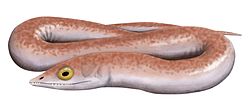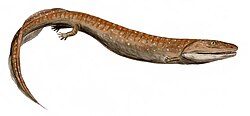| Chrysolepis Temporal range: | |
|---|---|
| Scientific classification | |
| Domain: | Eukaryota |
| Kingdom: | Animalia |
| Phylum: | Chordata |
| Clade: | Sarcopterygii |
| Clade: | Tetrapodomorpha |
| Order: | † Osteolepiformes |
| Family: | † Chrysolepididae Borgen & Nakrem, 2016 |
| Genus: | † Chrysolepis Lebedev, 1983 |
| Species: | †C. orlensis |
| Binomial name | |
| †Chrysolepis orlensis Lebedev, 1983 | |
Chrysolepis is a genus of prehistoric marine lobe-finned fish that lived during the Late Devonian period. [1] It contains a single species, C. orlensis, known from the middle Famennian of Oryol Oblast, Russia. [2] It is the only member of the family Chrysolepididae, erected due to its highly distinct morphology unseen among other osteolepiforms. It may be the sister taxon to the eusthenopterids. [3]





